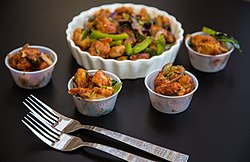Manchurian (dish)
 Chicken Manchurian served in Hyderabad | |
| Course | Snack |
|---|---|
| Place of origin | India |
| Region or state | West Bengal |
| Main ingredients | Cauliflower |
| Ingredients generally used | Chopped onion, capsicum, garlic |
Manchurian is a class of Indian Chinese dishes made by roughly chopping and deep-frying a main ingredient like chicken, cauliflower (gobi), prawns, fish, mutton or paneer cheese and then sautéeing it in a sauce flavored with soy sauce.[1][2] Manchurian is the result of the adaptation of Chinese cooking and seasoning techniques to suit Indian tastes and has become a staple of Indian Chinese cuisine.
History[edit]
The word "Manchurian" means native or inhabitant of Manchuria, but the dish is basically a creation of Chinese restaurants in India, and bears little resemblance to traditional Manchu cuisine or Chinese cuisine.[3] It is said to have been invented in 1975 by Nelson Wang, a cook at the Cricket Club of India in Mumbai, when a customer asked him to create a new dish, different from what was available on the menu.[4] Wang described his invention process as starting from the basic ingredients of an Indian dish, namely chopped garlic, ginger, and green chilis, but next, instead of adding garam masala, he put in soy sauce, followed by cornstarch and the chicken itself.[5] A popular vegetarian variant replaces chicken with cauliflower,[2] and is commonly known as gobi manchurian. Other vegetarian variants include mushroom, baby corn, veggie ball Manchurian.[citation needed]
Variations[edit]
There are two different variants of Manchurian, dry and with gravy. Both variants are prepared by using common ingredients like corn flour, maida flour, spring onion, bell peppers, soy sauce, chili sauce, minced garlic, ground pepper, etc. and has typical garnish of spring onion. Some recipes call for use of monosodium glutamate (MSG) to increase the taste profile, though there are those who avoid it due to health concerns.[6] Its taste can vary from mildly spicy to hot and fiery based on the recipe and personal preference.
Dry or crispy Manchurian[edit]
The fritters are served comparatively dry, often as a snack or starter with tomato ketchup as dipping sauce. It is popular among alcohol drinkers as a bar snack, and has been described as an "excellent drinking companion to cold beer".[7]
Manchurian with gravy[edit]
The fritters are coated with a thick sauce like spicy gravy curry made of corn flour. It is generally served with varieties of rice dishes like steamed rice, Chinese fried rice, Szechuan fried rice, as the main course.
See also[edit]
References[edit]
- ↑ Laxmi Parida (2003). Purba: Feasts from the East: Oriya Cuisine from Eastern India. iUniverse. p. 191. ISBN 978-0-595-26749-1.
- ↑ 2.0 2.1 "Manchurian chicken". The Straits Times. 2007-06-03. p. 77 – via NewspaperSG, National Library Board.
Thng, Lay Teen (2007-06-03). "Manchurian chicken". The Straits Times. Archived from the original on 2011-02-07. Retrieved 2010-04-21. - ↑ Mukherjee, Sipra; Gooptu, Sarvani. "The Chinese community of Calcutta". In Banerjee, Himadri (ed.). Calcutta Mosaic: Essays and Interviews on the Minority Communities of Calcutta. Anthem Press. pp. 131–142. ISBN 978-81-905835-5-8.
- ↑ "The short history of Indian Chinese food and where to breathe fire in Mumbai", CNN Go, 2010-02-11, archived from the original on 27 October 2012, retrieved 2010-04-21
- ↑ Bhagat, Rasheeda (2007-05-04). "Taste and disdain … A tour of the country's interesting eating habits with a roving journalist". The Hindu Businessline. Retrieved 2010-04-21.
- ↑ "Science suggests MSG really isn't bad for your health after all".
- ↑ https://food.ndtv.com/food-drinks/indian-chinese-food-how-hakka-noodles-and-manchurian-started-a-cult-cuisine-1735894

